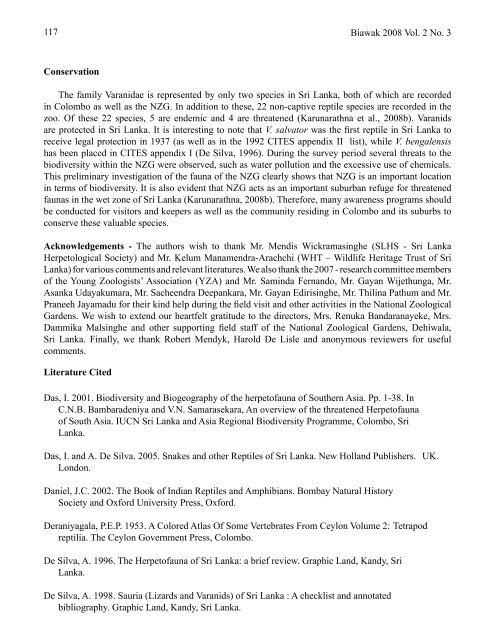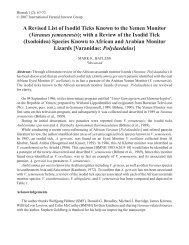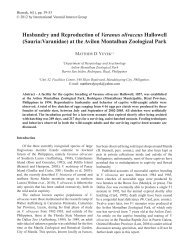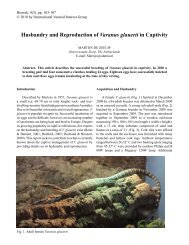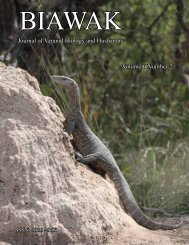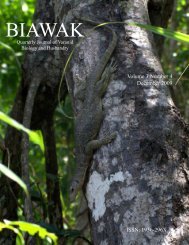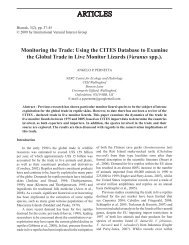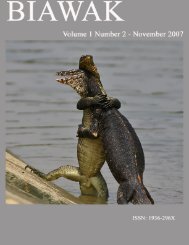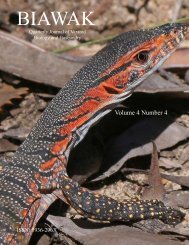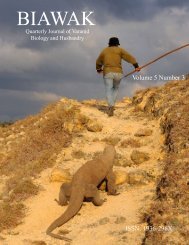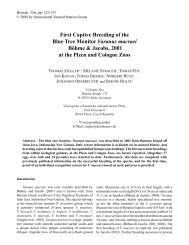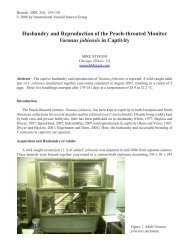Volume 2 Number 3 - International Varanid Interest Group
Volume 2 Number 3 - International Varanid Interest Group
Volume 2 Number 3 - International Varanid Interest Group
Create successful ePaper yourself
Turn your PDF publications into a flip-book with our unique Google optimized e-Paper software.
117 Biawak 2008 Vol. 2 No. 3ConservationThe family <strong>Varanid</strong>ae is represented by only two species in Sri Lanka, both of which are recordedin Colombo as well as the NZG. In addition to these, 22 non-captive reptile species are recorded in thezoo. Of these 22 species, 5 are endemic and 4 are threatened (Karunarathna et al., 2008b). <strong>Varanid</strong>sare protected in Sri Lanka. It is interesting to note that V. salvator was the first reptile in Sri Lanka toreceive legal protection in 1937 (as well as in the 1992 CITES appendix II list), while V. bengalensishas been placed in CITES appendix I (De Silva, 1996). During the survey period several threats to thebiodiversity within the NZG were observed, such as water pollution and the excessive use of chemicals.This preliminary investigation of the fauna of the NZG clearly shows that NZG is an important locationin terms of biodiversity. It is also evident that NZG acts as an important suburban refuge for threatenedfaunas in the wet zone of Sri Lanka (Karunarathna, 2008b). Therefore, many awareness programs shouldbe conducted for visitors and keepers as well as the community residing in Colombo and its suburbs toconserve these valuable species.Acknowledgements - The authors wish to thank Mr. Mendis Wickramasinghe (SLHS - Sri LankaHerpetological Society) and Mr. Kelum Manamendra-Arachchi (WHT – Wildlife Heritage Trust of SriLanka) for various comments and relevant literatures. We also thank the 2007 - research committee membersof the Young Zoologists’ Association (YZA) and Mr. Saminda Fernando, Mr. Gayan Wijethunga, Mr.Asanka Udayakumara, Mr. Sacheendra Deepankara, Mr. Gayan Edirisinghe, Mr. Thilina Pathum and Mr.Praneeh Jayamadu for their kind help during the field visit and other activities in the National ZoologicalGardens. We wish to extend our heartfelt gratitude to the directors, Mrs. Renuka Bandaranayeke, Mrs.Dammika Malsinghe and other supporting field staff of the National Zoological Gardens, Dehiwala,Sri Lanka. Finally, we thank Robert Mendyk, Harold De Lisle and anonymous reviewers for usefulcomments.Literature CitedDas, I. 2001. Biodiversity and Biogeography of the herpetofauna of Southern Asia. Pp. 1-38. InC.N.B. Bambaradeniya and V.N. Samarasekara, An overview of the threatened Herpetofaunaof South Asia. IUCN Sri Lanka and Asia Regional Biodiversity Programme, Colombo, SriLanka.Das, I. and A. De Silva. 2005. Snakes and other Reptiles of Sri Lanka. New Holland Publishers. UK.London.Daniel, J.C. 2002. The Book of Indian Reptiles and Amphibians. Bombay Natural HistorySociety and Oxford University Press, Oxford.Deraniyagala, P.E.P. 1953. A Colored Atlas Of Some Vertebrates From Ceylon <strong>Volume</strong> 2: Tetrapodreptilia. The Ceylon Government Press, Colombo.De Silva, A. 1996. The Herpetofauna of Sri Lanka: a brief review. Graphic Land, Kandy, SriLanka.De Silva, A. 1998. Sauria (Lizards and <strong>Varanid</strong>s) of Sri Lanka : A checklist and annotatedbibliography. Graphic Land, Kandy, Sri Lanka.


